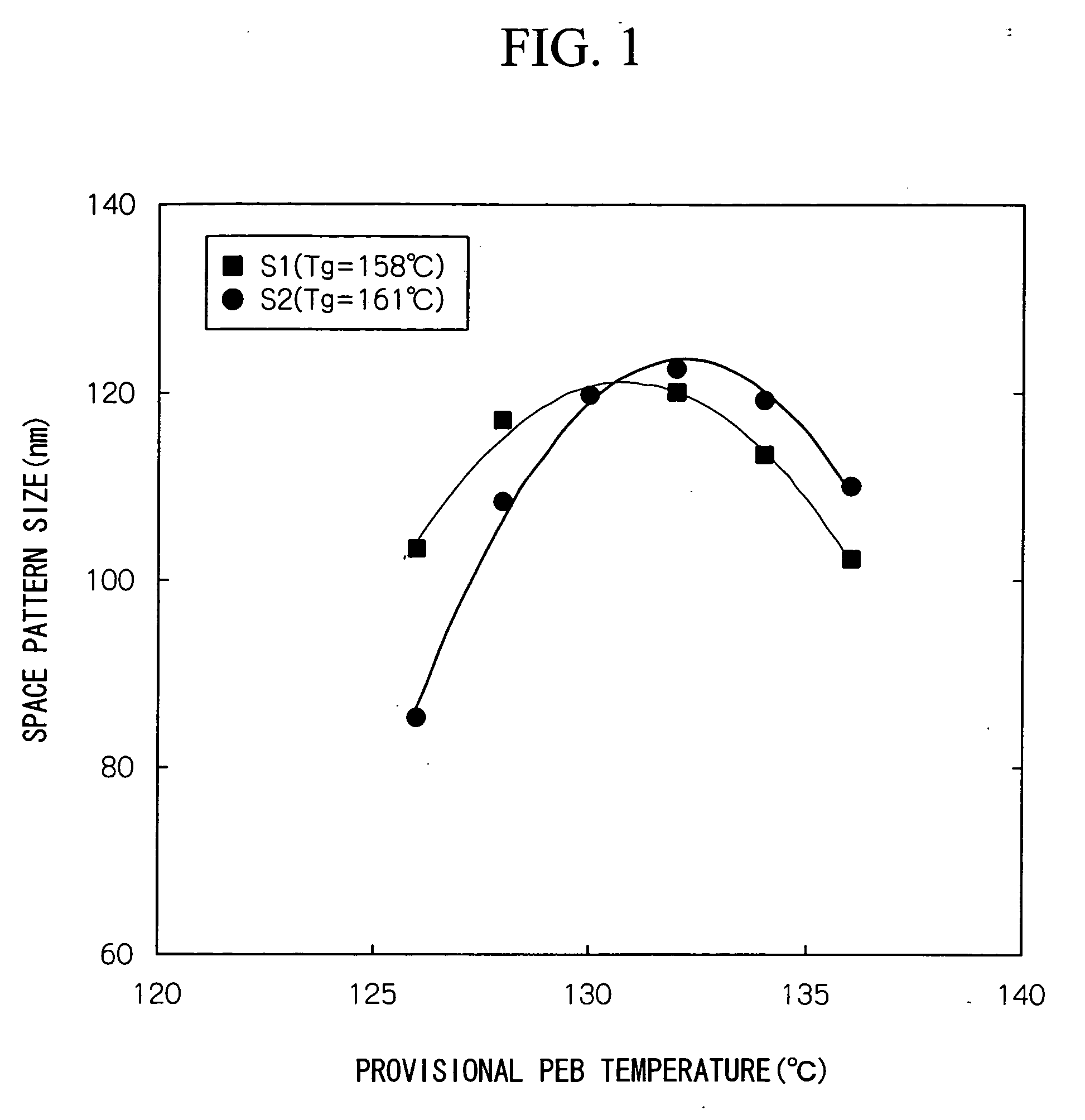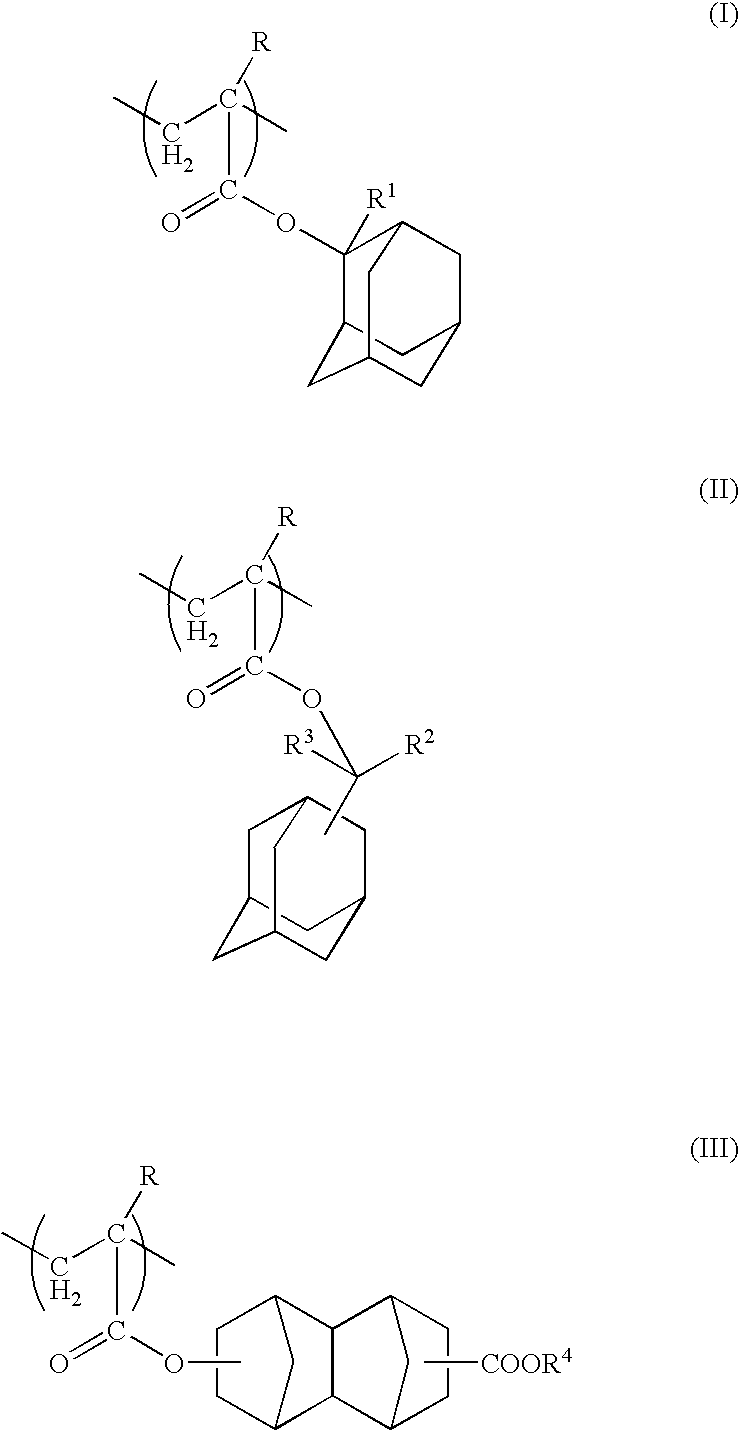Positive resist composition and method for forming resist pattern
a technology of resist and composition, which is applied in the field of composition of positive resist, can solve the problems of significant increase in the solubility of resist in the developing solution within these exposed portions, insufficient transparency of benzene rings in the vicinity of 193 nm, and lower resolution of chemically amplified resists using these resins as a base resin, etc., and achieves high sensitivity and resolution.
- Summary
- Abstract
- Description
- Claims
- Application Information
AI Technical Summary
Benefits of technology
Problems solved by technology
Method used
Image
Examples
example 1
[0156] 100 parts by weight of a copolymer represented by structural formulas shown below (weight average molecular weight: 5,300, polydispersity: 2.06, Tg: 147° C.), together with 2.0 parts by weight of p-methylphenyldiphenylsulfonium nonafluorobutanesulfonate and 0.8 parts by weight of tri(tert-butylphenyl)sulfonium trifluoromethanesulfonate as an acid generator component, and 0.25 parts by weight of triethanolamine as a nitrogen-containing organic compound component were dissolved in 25 parts by weight of γ-butyrolactone and 900 parts by weight of a mixture (weight ratio 8:2) of propylene glycol monomethyl ether acetate and ethyl lactate, thus yielding a positive resist composition.
(wherein, n:m:l=40 mol %: 40 mol %: 20 mol %)
[0157] Subsequently, an organic anti-reflective film composition ARC-29A (a product name, manufactured by Brewer Science Ltd.) was applied to the surface of a silicon wafer using a spinner, and the composition was then baked and dried on a hotplate at 215...
example 2
[0161] With the exception of replacing the copolymer of the example 1 with 100 parts by weight of a copolymer of the same structural formulas but with a weight average molecular weight of 7,800, a polydispersity of 1.98, and a Tg value of 160° C., a positive resist composition was prepared with the same composition as that of the example 1.
[0162] When patterning was then conducted in the same manner as the example 1, the resolution for a trench pattern when exposure was conducted using the same exposure dose of 23 mJ / cm2 required to transfer a 130 nm mask obtained using the positive resist composition of this example at 130 nm, was 131 nm, and the pattern shape was favorable.
[0163] Furthermore, when the difference between the maximum size and minimum size of each of the resist patterns formed on the wafer was determined, the result of 2 to 3 nm was extremely small, indicating a satisfactorily high level of in-plane uniformity.
[0164] Furthermore, in order to determine the PEB marg...
example 3
[0165] With the exception of replacing the copolymer of the example 1 with 100 parts by weight of a copolymer of the same structural formulas but with a weight average molecular weight of 6,500, a polydispersity of 1.59, and a Tg value of 161° C., a positive resist composition was prepared with the same composition as that of the example 1.
[0166] When patterning was then conducted in the same manner as the example 1, the resolution for a trench pattern when exposure was conducted using the same exposure dose of 22 mJ / cm2 required to transfer a 130 nm mask obtained using the positive resist composition of this example at 130 nm, was 137 nm, and the pattern shape was favorable.
[0167] Furthermore, when the difference between the maximum size and minimum size of each of the resist patterns formed on the wafer was determined, the result of 2 to 3 nm was extremely small, indicating a satisfactorily high level of in-plane uniformity.
[0168] Furthermore, in order to determine the PEB marg...
PUM
| Property | Measurement | Unit |
|---|---|---|
| Temperature | aaaaa | aaaaa |
| Temperature | aaaaa | aaaaa |
| Percent by mass | aaaaa | aaaaa |
Abstract
Description
Claims
Application Information
 Login to View More
Login to View More - R&D
- Intellectual Property
- Life Sciences
- Materials
- Tech Scout
- Unparalleled Data Quality
- Higher Quality Content
- 60% Fewer Hallucinations
Browse by: Latest US Patents, China's latest patents, Technical Efficacy Thesaurus, Application Domain, Technology Topic, Popular Technical Reports.
© 2025 PatSnap. All rights reserved.Legal|Privacy policy|Modern Slavery Act Transparency Statement|Sitemap|About US| Contact US: help@patsnap.com



